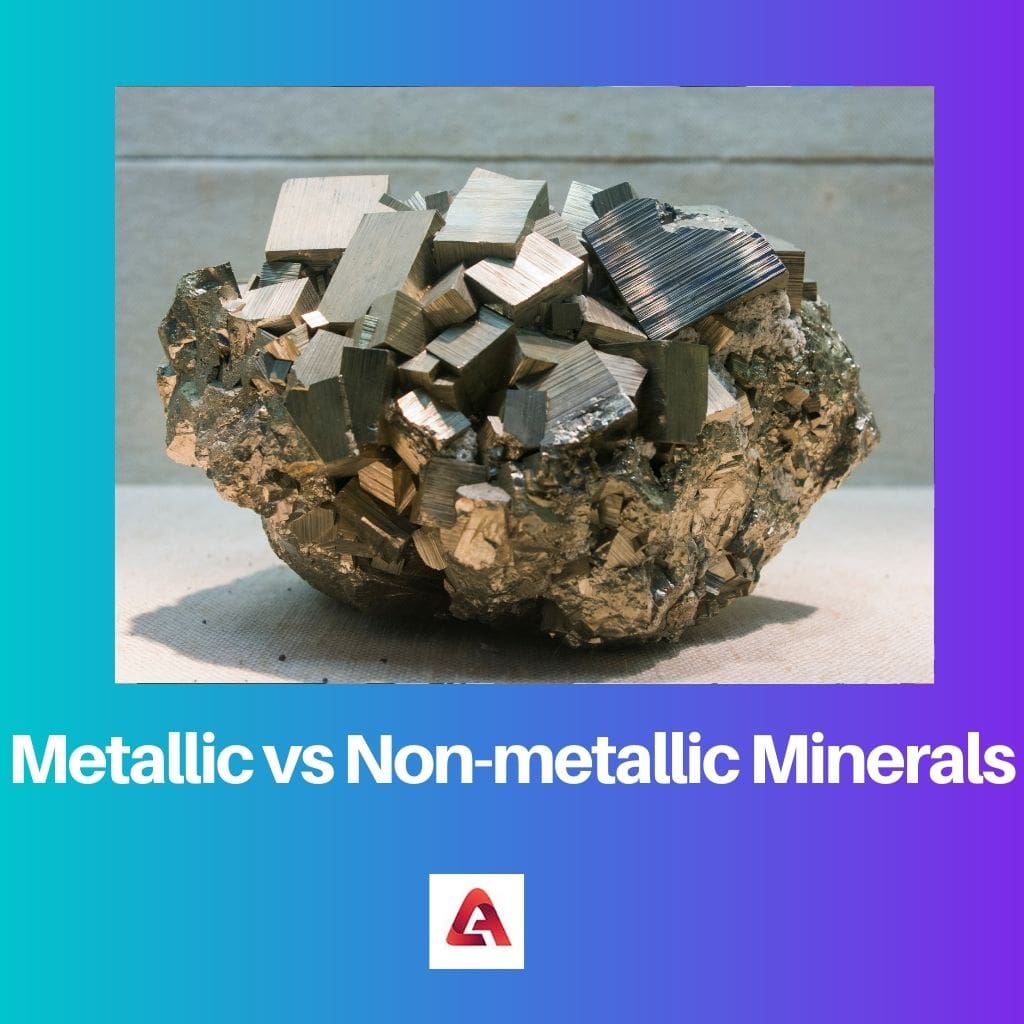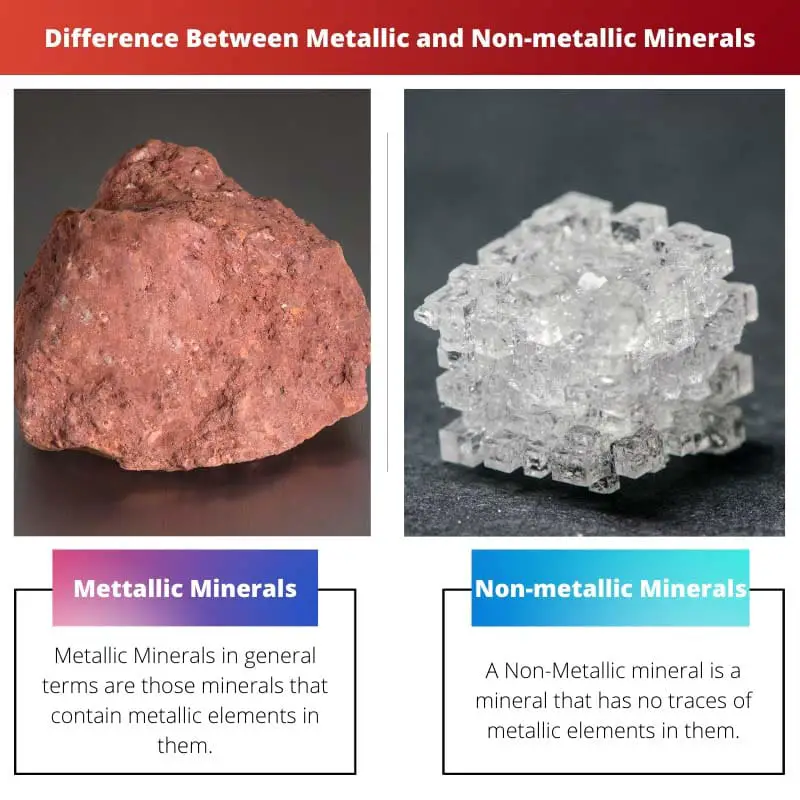Metallic minerals contain metals in their chemical composition. They are associated with high luster and conductivity. In contrast, non-metallic minerals do not contain metals and have characteristics such as transparency, low conductivity, and a lack of metallic luster.
Key Takeaways
- Metallic minerals contain metals in their chemical composition, resulting in a lustrous appearance and high electrical and thermal conductivity.
- Non-metallic minerals lack metallic properties, exhibiting a non-lustrous appearance and poor electrical and thermal conductivity.
- Both minerals are vital resources, with metallic minerals used in manufacturing and technology, while non-metallic minerals serve various industries, including construction and agriculture.
Metallic vs Non-metallic Minerals
Metallic minerals contain metals such as iron, copper, gold, silver, and zinc. These minerals have a shiny, metallic luster and are hard and dense. Non-metallic minerals are minerals that do not contain metals. They are light in color and have a dull or earthy luster. Non-metallic minerals are less dense and less hard than metallic minerals.

Examples of metallic minerals are bauxite, iron, and tin; examples of non-metallic minerals are salt, marble, and coal.
Comparison Table
| Feature | Metallic Minerals | Non-metallic Minerals |
|---|---|---|
| Chemical Composition | Primarily composed of metal elements | Composed of non-metal elements and sometimes metal oxides |
| Examples | Iron, copper, gold, silver, aluminum | Salt, gypsum, sulfur, clay, sand, limestone |
| Physical Properties | Lustrous, ductile, malleable, good conductors of heat and electricity | Non-lustrous, brittle, non-ductile, non-malleable, poor conductors of heat and electricity |
| Melting Point | High melting point | Can have a wide range of melting points from low to high |
| Occurrence | Found in veins, lodes, and disseminated deposits | Found in sedimentary rocks, evaporites, and metamorphic rocks |
| Mining Methods | Typically mined underground or through open pit mining | Can be mined through surface mining, underground mining, or quarrying |
| Processing | Requires smelting and refining to extract the metal | Processing methods vary depending on the mineral and its intended use |
| Uses | Building materials, machinery, transportation, electronics, consumer goods | Construction, agriculture, chemicals, pharmaceuticals, cosmetics, abrasives, fertilizers |
| Economic Importance | Very high economic value due to their widespread use | Varies depending on the specific mineral and its applications |
| Environmental Impact | Mining and processing of metallic minerals can have a significant environmental impact | Environmental impact of mining and processing non-metallic minerals can vary depending on the mineral and the mining methods used |
What is Metallic Mineral?
A metallic mineral is a type of mineral that contains one or more metal elements in its raw form. These metals are in their natural state, combined with other elements or compounds. Unlike non-metallic minerals, metallic minerals possess distinct physical properties that make them valuable and widely used in numerous industries.
Here are some key characteristics of metallic minerals:
Chemical composition:
- Primarily composed of metal elements, such as iron, copper, gold, silver, aluminum, etc.
- May contain small amounts of other elements, such as oxygen, sulfur, or carbon.
Physical properties:
- Lustrous: Have a shiny or metallic appearance.
- Ductile: Can be drawn into thin wires without breaking.
- Malleable: Can be hammered into thin sheets without breaking.
- Good conductors of heat and electricity: Efficiently transfer heat and electricity.
- High melting point: Usually require high temperatures to melt.
Occurrence:
- Found in various geological formations, including veins, lodes, and disseminated deposits.
- May be present in igneous, metamorphic, or sedimentary rocks.
Mining and processing:
- Extracted through mining methods like underground or open-pit mining.
- Require smelting and refining processes to separate the metal from other elements and compounds.
Uses:
- Play a crucial role in various industries, including:
- Building materials (steel, aluminum)
- Machinery and transportation (cars, airplanes)
- Electronics and electrical appliances
- Consumer goods (jewelry, utensils)
Economic importance:
- Metallic minerals have high economic value due to their widespread use and essential properties.
- The global demand for metallic minerals continues to grow, driving exploration and mining activities.
Examples of metallic minerals:
- Iron ore
- Copper ore
- Gold ore
- Silver ore
- Aluminum ore (bauxite)
Environmental impact:
- Mining and processing metallic minerals can have a significant environmental impact, including deforestation, water pollution, and air pollution.
- Sustainable mining practices and responsible resource management are crucial to minimize these impacts.
Metallic minerals are essential natural resources contributing significantly to technological advancement, infrastructure development, and the global economy. Understanding their characteristics, uses, and environmental implications is crucial for promoting responsible resource management and securing a sustainable future.

What is Non-Metallic Mineral?
A non-metallic mineral is a type of mineral that does not contain metallic elements in its raw form. Instead, these minerals comprise various non-metallic elements and sometimes metal oxides. They exhibit different physical properties than their metallic counterparts, leading to diverse applications in various fields.
Here are the key characteristics of non-metallic minerals:
Chemical composition:
- Composed mainly of non-metallic elements like carbon, oxygen, silicon, sulfur, etc.
- May contain small amounts of metal oxides.
Physical properties:
- Non-lustrous: Lack of metallic shine.
- Brittle: Tend to shatter or break easily.
- Non-ductile and non-malleable: Cannot be drawn into wires or hammered into sheets.
- Poor conductors of heat and electricity: Do not efficiently transfer heat and electricity.
- Melting points can vary greatly, ranging from low to high.
Occurrence:
- Found in diverse geological formations, including sedimentary rocks, evaporites, and metamorphic rocks.
- Examples include sand, gravel, limestone, clay, salt, and gypsum.
Mining and processing:
- Extraction methods depend on the specific mineral and its intended use.
- Surface mining, underground mining, and quarrying are prevalent approaches.
- Processing methods vary considerably and may involve crushing, grinding, separating, or refining the mineral.
Uses:
- Employed in numerous industries and applications, such as:
- Construction materials (cement, concrete, bricks)
- Agriculture (fertilizers, soil amendments)
- Chemicals and pharmaceuticals
- Cosmetics and personal care products
- Abrasives and polishes
- Glass and ceramics
Economic importance:
- Non-metallic minerals play a vital role in various industries and contribute significantly to the global economy.
- Their economic value varies depending on the specific mineral and its applications.
Examples of non-metallic minerals:
- Sand
- Gravel
- Limestone
- Clay
- Salt
- Gypsum
- Sulfur
- Graphite
- Mica
- Asbestos
Environmental impact:
- Mining and processing non-metallic minerals can also have environmental impacts, including land degradation, dust pollution, and water resource depletion.
- Implementing environmentally friendly mining practices and responsible resource management minimizes these impacts.
Non-metallic minerals represent a diverse and essential group of natural resources contributing to our daily lives. Understanding their characteristics, uses, and environmental implications fosters responsible resource management and promotes a sustainable future.

Main Differences Between Metallic Minerals and Non-Metallic Minerals
- Composition:
- Metallic Minerals: Metallic minerals are composed of elements that have metallic properties, such as iron, copper, gold, silver, and aluminum.
- Non-Metallic Minerals: Non-metallic minerals do not contain metals as a primary component and are composed of non-metallic elements or compounds, such as quartz, limestone, gypsum, and talc.
- Appearance and Luster:
- Metallic Minerals: Metallic minerals have a characteristic metallic luster, reflecting light and appearing shiny and opaque.
- Non-Metallic Minerals: Non-metallic minerals may have various appearances, such as transparent, translucent, or opaque, and lack the metallic luster.
- Conductivity:
- Metallic Minerals: Metallic minerals are good conductors of heat and electricity due to the presence of metal elements.
- Non-Metallic Minerals: Non-metallic minerals are poor conductors of heat and electricity.
- Usage:
- Metallic Minerals: Metallic minerals are valued for their metal content and are primarily used in industries such as metallurgy, construction, and manufacturing for producing metals and alloys.
- Non-Metallic Minerals: Non-metallic minerals have diverse uses, including in construction materials (e.g., sand, gravel, and limestone), ceramics, glass production, agriculture (e.g., fertilizers), and cosmetics (e.g., talc).
- Economic Significance:
- Metallic Minerals: Metallic minerals are more economically valuable due to the metals they contain, and they play a crucial role in mining and the global economy.
- Non-Metallic Minerals: Non-metallic minerals are valuable in their own right but may not command as high prices as metals; their economic significance varies depending on their specific applications.
- Examples:
- Metallic Minerals: Examples of metallic minerals include iron ore (hematite and magnetite), copper ore (chalcopyrite), gold, silver, aluminum ore (bauxite), and lead-zinc ores.
- Non-Metallic Minerals: Examples of non-metallic minerals include quartz, limestone, gypsum, talc, clay, graphite, and mica.
- Mining Methods:
- Metallic Minerals: Metallic minerals are extracted through underground mining, open-pit mining, and heap leaching, depending on the ore’s characteristics.
- Non-Metallic Minerals: Non-metallic minerals are extracted using quarrying, surface mining, or drilling and blasting methods.

- https://pdfs.semanticscholar.org/e6ac/fc0d28d5b80828372faffca47821c2d53422.pdf
- https://www.osti.gov/biblio/6752942
- https://www.earthdoc.org/content/journals/10.1111/j.1365-2478.1965.tb01952.x

The article effectively outlines the key characteristics and uses of metallic and non-metallic minerals, offering valuable insights into their industrial and economic importance.
Absolutely, Holmes Grace. It’s a well-researched piece that enhances our understanding of the diverse applications and implications of these minerals.
The article offers a valuable insight into the chemical compositions, physical properties, and uses of metallic and non-metallic minerals, providing a comprehensive guide to these essential resources.
Indeed, Jodie Lloyd. It’s a well-articulated piece that enhances our understanding of the subject matter.
While the article is informative, it lacks a critical analysis of the environmental impacts associated with mining and processing metallic and non-metallic minerals, which is essential for a comprehensive understanding.
I concur with Turner Cameron. A more detailed examination of environmental impacts would contribute to a more holistic understanding.
I see your point, Turner Cameron. A deeper exploration of the environmental consequences would indeed enrich the article’s scope.
This comprehensive article is an essential read for those seeking to gain a profound understanding of metallic and non-metallic minerals and their impact on various industries.
Indeed, Hunter Sofia. The article provides a wealth of knowledge about these minerals, emphasizing their significance in industrial and environmental contexts.
The article presents a thorough examination of metallic and non-metallic minerals, elucidating their chemical compositions, physical properties, mining methods, and more.
Absolutely, Adams William. The article serves as an excellent guide in understanding the crucial distinctions and applications of these minerals.
The comprehensive comparison table and detailed explanations effectively communicate the key differences and characteristics of metallic and non-metallic minerals.
The article’s structure allows for a systematic understanding of the topic. It’s a valuable resource for anyone interested in minerals.
I totally agree, Jlewis. The clarity and depth of information in this article are commendable.
This article is an enlightening piece of work! It provides in-depth knowledge about the differences between metallic and non-metallic minerals, as well as their uses and environmental impact!
Absolutely, the article offers comprehensive information that is crucial in understanding the significance of these minerals in various industries.
I appreciate how well-structured and informative this article is. It truly enhances our understanding of the subject matter.
While the article provides valuable information, I feel that certain areas could be more in-depth to provide a clearer understanding of the economic and environmental impact of these minerals.
I agree with Nharris. A more detailed exploration of the economic importance and environmental impact would further enrich the content of the article.
I understand your point, Nharris. Perhaps additional details about the specific environmental and economic implications would be beneficial.
The article effectively highlights the stark differences between metallic and non-metallic minerals, shedding light on their diverse properties and applications.
I concur, Green Daniel. The detailed comparison and insightful descriptions provide a comprehensive overview of these essential resources.
Indeed, the content is well-researched and educational, making it a valuable resource for those seeking comprehensive knowledge about minerals.
While the article provides detailed information about metallic and non-metallic minerals, it might benefit from a more engaging narrative style to captivate the readers’ attention.
I see your point, Palmer Graham. Adding an engaging narrative element would indeed enhance the overall appeal of the article.
I agree with Palmer Graham. A more captivating storytelling approach would make the content more engaging for readers.